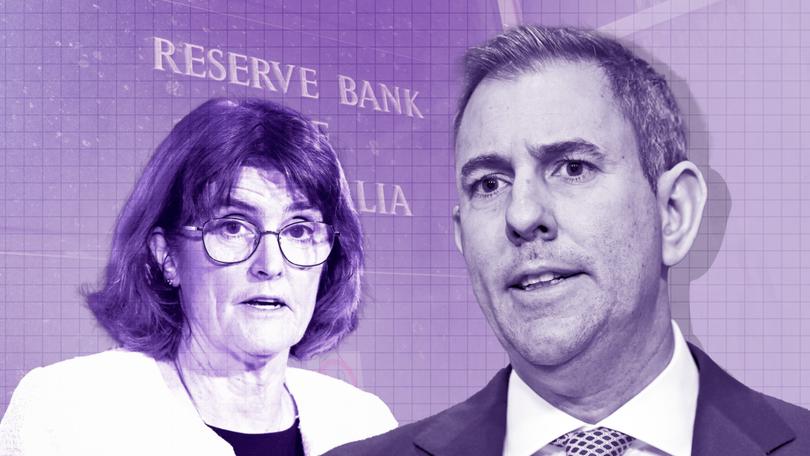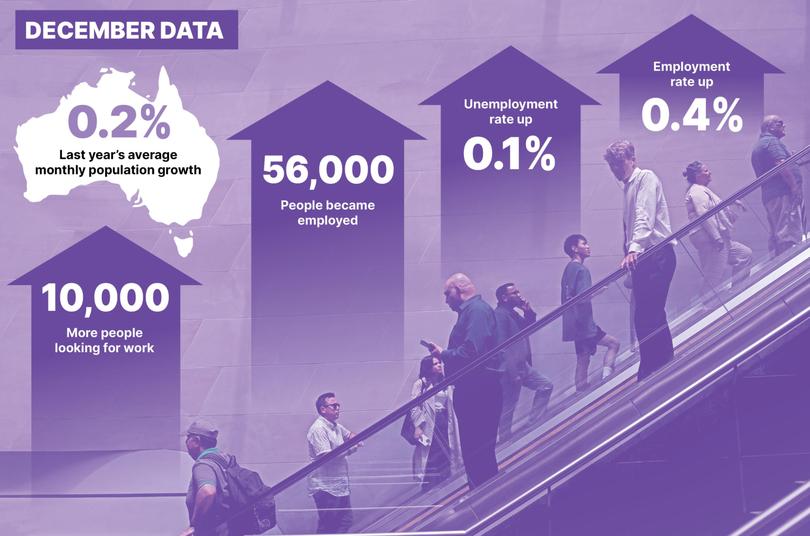Unemployment: Jobless rate rises to 4 per cent as Reserve Bank mulls rate cut

A better than expected jobs report has economists divided over when the Reserve Bank will cut rates at its next February meeting, setting up inflation data to be released on 29 January, as a make or break for the election.
While the market is pricing in a 70 per cent chance of a cut next month, today’s figures show an economy that continues to power along from a jobs perspective at four per cent, below the RBA’s forecast for unemployment of 4.3 per cent, and suggesting there is room for the Bank to adopt a wait and see approach.
The ABS figures show the unemployment continues to bob around record lows and far below the pre-pandemic average of above five per cent.
Sign up to The Nightly's newsletters.
Get the first look at the digital newspaper, curated daily stories and breaking headlines delivered to your inbox.
By continuing you agree to our Terms and Privacy Policy.In sign of confidence, participation rate jumped to a record high, as did hours worked. 56,000 new jobs were created last month, but most of those were part time, suggesting that employment growth may not quite as strong as the headline figures suggest.
“The composition of jobs growth took the gloss off the big lift in employment,” said Commonwealth Bank head economist, Gareth Aird.
Commbank is sticking by its call for a 0.25 per cent rate cut next month, citing very weak GDP that is being propped up by government spending.
“GDP per capita has been going backwards, and there’s been no real growth in private demand for a few quarters. So the growth you’re getting in you coming via public spending, whereas private demands quite weak,” Mr Aird said.
“From an economic growth perspective, we’re growing well below trend at the moment, and historically, that’s consistent with an uptrend the unemployment rate. That hasn’t come through yet, but the labour market does tend to lag the GDP data.”

Commbank sees an economy still tied down by restrictive interest rates, that is keeping the private sector from investing. Despite the pickup in Black Friday sales, but not commensurate with the scale of the Stage 3 tax cuts. Households are mostly saving rather than spending, consumer confidence is weak and house prices are turning downwards in the major markets.
All eyes are now on the inflation data print on 29 January.
“If the inflation data coming out in January, is sufficiently good, the case to start cutting rates, is a pretty strong one.”
Westpac is keeping its forecast for a May rate cut.
Luci Ellis, Westpac chief economist and a former deputy governor of the RBA believes there is enough strength in the labour market, without a wages breakout to give the RBA Board pause.
“The real key thing is that wages growth has actually unwound quite a bit,” Ms Ellis said, despite unemployment being below its ‘natural rate’, or NAIRU of 4.5 per cent.
“(The RBA) would still see the economy as being tight for that reason.”
The game changer, for Ms Ellis, is inflation.
If the January data shows inflation coming lower than the RBA’s current forecast, a rate cut is more “line ball.”
“They’re not in a hurry, and they don’t need to be in a hurry, particularly given the labour market isn’t unravelling at the moment,” Ms Ellis said.
Public Sector driving employment
Treasurer Jim Chalmers welcomed the jobs data today, saying Australia was rare among global peers in holding unemployment low, while dealing with post-pandemic inflation.
“Unemployment is higher in Canada, New Zealand, the US, the UK, the rest of Europe,” he said. “They’ve paid for progress on inflation with much higher unemployment, we’ve been able to do better than that.”
While Mr Chalmers points to an unemployment rate “lower than any other government of the last 50 years,” it has been achieved by a massive uplift in government spending.
ABS labour data last year revealed the fastest growing sectors were health care and social assistance and public administration and safety, rising by more than 10 per cent annually.
Throw in “non-market” jobs, which are publicly funded private sector jobs in health, education and public administration and 84 per cent of the 473,000 jobs created in Australia rely on government coffers, according the Australian Industry Group.
“Today’s employment data shows the labour market ended the year strongly, but a growing reliance on government-funded jobs augurs poorly for 2025,” Innes Willox, Chief Executive of the AIG, said.
The AIG worries that when the taxpayer-funded jobs boom runs out, the private sector may not be ready to pick up the slack.
“Employers concur with Jim Chalmers’ assessment that ‘the best kind of growth is private sector-led growth’. It is therefore imperative governments make restarting investment, job creation and growth in the private sector a top priority for 2025,” Mr Willox said.
Heading into the election, employment won’t be a core focus of voters however. Much like the Reserve Bank, citizens are mostly agnostic about who their employer is.
While business groups want to encourage private sector jobs and growth, a more pressing concern for voters will be the inflation data on 29 January. If it comes in as expected, then Labor has a positive story to tell on engineering a soft landing.
The most recent retail sales figures show shoppers are focused on discounts, opening their wallets for sales, while avoiding full price, but by saving a greater than expected portion of their tax cuts, which may help with a greater sense of financial confidence.
Ms Ellis points to strong data in building activity as another positive sign.
Another plus for the government, Ms Ellis said, was the falling Australian dollar’s effect on iron ore revenues.
“The Aussie dollar has fallen nearly 10 per cent against the US dollar and that means that the Australian dollar equivalent of the mining sector profits is therefore bigger,” she said. “So there’s a gain for tax revenue.”

